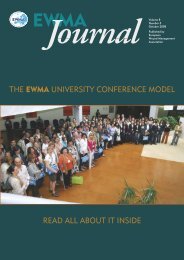best practice for the management of lymphoedema ... - EWMA
best practice for the management of lymphoedema ... - EWMA
best practice for the management of lymphoedema ... - EWMA
You also want an ePaper? Increase the reach of your titles
YUMPU automatically turns print PDFs into web optimized ePapers that Google loves.
TABLE 5 Components <strong>of</strong> MLLB (in order <strong>of</strong> use)<br />
Component<br />
1. Skin care<br />
2. Finger or toe bandaging<br />
(if indicated)<br />
3. Tubular bandage<br />
4. S<strong>of</strong>t syn<strong>the</strong>tic wool<br />
(‘sub-compression<br />
wadding bandage') or<br />
foam roll or sheet<br />
5. Dense foam<br />
6. Inelastic bandages<br />
7. Tape<br />
Purpose<br />
To optimise skin health and<br />
treat any skin conditions, eg<br />
hyperkeratosis or ulceration<br />
To prevent or reduce swelling<br />
<strong>of</strong> <strong>the</strong> fingers<br />
To reduce swelling <strong>of</strong> <strong>the</strong> toes<br />
To provide a protective,<br />
absorbent layer between <strong>the</strong><br />
skin and o<strong>the</strong>r bandages<br />
To protect <strong>the</strong> skin and<br />
subcutaneous tissues, to<br />
normalise shape*, to protect<br />
bony prominences and to<br />
equalise <strong>the</strong> distribution <strong>of</strong><br />
pressure produced by o<strong>the</strong>r<br />
bandage layers<br />
Applied locally to s<strong>of</strong>ten hard<br />
areas <strong>of</strong> tissue thickening* or<br />
areas particularly vulnerable<br />
to oedema, eg <strong>the</strong> malleoli<br />
To provide compression<br />
To secure ends <strong>of</strong> bandages<br />
Characteristics<br />
According to need<br />
Con<strong>for</strong>ming bandage<br />
A light cotton or cotton-viscose<br />
bandage applied to <strong>the</strong> whole area to be<br />
bandaged<br />
Does not contribute significantly to<br />
compression<br />
S<strong>of</strong>t syn<strong>the</strong>tic wool or polyurethane<br />
foam is available in different widths and<br />
thicknesses, and as bandages or sheets<br />
Polyester undercast padding is available<br />
in sheets <strong>of</strong> various widths<br />
Higher densities <strong>of</strong> foam are used with<br />
greater degrees <strong>of</strong> shape distortion or<br />
tissue thickening<br />
Polyurethane high density foam is<br />
available in sheets or pads <strong>of</strong> different<br />
thicknesses that can be cut to shape<br />
Constructed <strong>of</strong> crimped cotton yarns<br />
Available as nonadhesive, cohesive or<br />
adhesive<br />
Most types are available in 4cm, 6cm,<br />
8cm, 10cm and 12cm widths<br />
BOX 24 Laplace's Law 71<br />
P = T x N x 4630<br />
C x W<br />
P = sub-bandage pressure (mmHg)<br />
T = bandage tension (kilograms <strong>for</strong>ce – kgf)<br />
N = number <strong>of</strong> layers<br />
C = limb circumference (cm)<br />
W =bandage width (cm)<br />
MLLB<br />
BEST PRACTICE FOR THE MANAGEMENT OF LYMPHOEDEMA 33<br />
Notes<br />
As a minimum, emollient<br />
should be applied to <strong>the</strong> skin<br />
be<strong>for</strong>e bandaging<br />
Bandaging should not impede<br />
function <strong>of</strong> digits<br />
Should be long enough to be<br />
folded back over <strong>the</strong> padding<br />
layer at ei<strong>the</strong>r end to prevent<br />
fraying or chafing<br />
Extra padding may be required<br />
on vulnerable pressure points<br />
such as <strong>the</strong> Achilles' tendon,<br />
dorsum <strong>of</strong> <strong>the</strong> foot, tibialis<br />
anterior tendon, <strong>the</strong> malleoli,<br />
<strong>the</strong> popliteal fossa and <strong>the</strong><br />
elbow<br />
Applied over s<strong>of</strong>t syn<strong>the</strong>tic<br />
wool or under foam<br />
Edges should be bevelled to<br />
prevent rubbing<br />
Several layers are used<br />
Cohesive and adhesive<br />
bandages can help to prevent<br />
slippage and are used to<br />
prolong <strong>the</strong> time <strong>the</strong> bandage<br />
is worn<br />
The tape appropriate to <strong>the</strong><br />
bandage being secured should<br />
be used<br />
*Foam chip bags contain low density foam pieces in a tubular bandage and can be used to bulk out areas such as <strong>the</strong> palm <strong>of</strong> <strong>the</strong> hand or over areas <strong>of</strong> tissue<br />
thickening.<br />
Achieving <strong>the</strong> desired pressure<br />
The pressure produced by a compression<br />
bandage can be predicted according to<br />
Laplace's Law (Box 24). This law shows that<br />
sub-bandage pressure will:<br />
■ rise with increasing bandage tension and<br />
number <strong>of</strong> bandage layers<br />
■ decrease with increasing limb<br />
circumference and bandage width.<br />
In <strong>practice</strong>, <strong>the</strong>re<strong>for</strong>e, Laplace's Law shows<br />
that <strong>for</strong> a larger limb requiring high levels <strong>of</strong><br />
compression, <strong>the</strong> desired pressure may be<br />
achieved by increasing <strong>the</strong> number <strong>of</strong><br />
bandage layers applied and increasing <strong>the</strong><br />
tension used during application.<br />
Frequency <strong>of</strong> MLLB system change<br />
As yet, <strong>the</strong>re is no empirical evidence to<br />
indicate how frequency <strong>of</strong> bandage change<br />
affects speed <strong>of</strong> oedema reduction or final<br />
outcome. Clinical experience recommends<br />
that MLLB systems should be changed daily

















